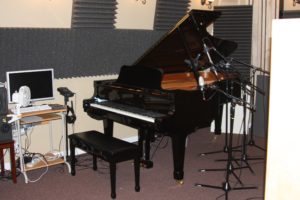Full Range Instrument
When we have a piano in the room, we have an instrument that is capable of producing all frequencies that the human ear can assimilate. We can go down to 20 Hz. and upwards past 10,000 cycles which gives us a representation of all of our hearing critical bands. It is a powerful source and must be granted the utmost acoustic consideration ans respect.
Stay Away From Walls
Since it is a physically large instrument, it must not be placed next to a wall. This is just an absolute no when it comes to acoustics. There are many nos but this one is high upon the list. The first energy boundary reflection point can not be a wall that is one foot away. Don’t do that to the room and please do not do that to the piano. Put the piano in the center of the room.
Room Center Placement
By placing the piano in room center, we fit the piano into the room acoustically. Since our sound energy from the piano is radiating at many 360 degree radius, we allow that direct sound source energy to radiate from the piano into the room. If all room surface ares are away from our piano source, we are staying acoustically true to the instrument itself. The room will add its own stink to our sound but by placing the piano in room center at least we have a chance of minimizing or maximizing that room sound.
Elevate Don’t Deviate
Our next surface issue is the floor. The floor is the closest surface next to our piano unless we shove the piano against the wall which we have agreed never to do. We must raise the piano off of the floor. It must be elevated from the floor as much as our room height will allow for. If we have 30′ ceilings, raise it 5′ in the air. If we have 12′ ceilings raise it 2′. This will improve instrument and room response.
Vibrations
Vibrational energy from the piano to the elevated platform, needs to be managed. Vibrational isolators must be chosen to compliment the vibrational energy ranges exhibited by the piano to surface area. These isolation devices can also be used to produce different piano sounds especially when it comes to attack and decay rates.
Absorption And Diffusion
Room treatment in our room, should be a combination of absorption and diffusion for all room boundary surfaces except the floor. Diffusion can add to the spaciousness of the already spacious piano sound especially at the microphone position. Reflections can be minimized through diffusion and can be spread out away from the direct sound of the piano. Absorption can be distributed to absorb any excess energy that would contribute to unwanted room decay times.
Variable Acoustics
If possible, a variable acoustic room treatment program would be desirable. The ability to alternate between different acoustic technologies at will and on all surfaces would be a valuable tool. In a rectangular room it would be desirable to have the flexibility of changing the acoustical treatment on the short side or rear walls versus the others. Having a variable acoustic ceiling in a piano room would be highly welcome especially by the microphones themselves.
Platform Acoustics
Since our piano is elevated on a platform, we now have space for acoustic treatment. We must now address the lower frequencies that can get trapped between the platform and the piano. We raised the piano off of the existing floor to improve room frequency response, now we must deal with resonances that will exist between the piano and its new platform.
Comb Filtering
These are resonances that occur from two physical objects in close proximity to one another, one of which is a sound producing instrument. We will have mostly mid frequency and low frequency resonances to content with. They will be over a limited frequency range, but they are there. We need to absorb them because they can blur or smear those instruments that generate sound within those frequencies.
Reduce Carefully
We also need to absorb these resonances at an even rate no matter what level of frequency absorption we design for. Our absorption goal will be to reduce all troubling frequencies at just enough in level to reduce their sonic impact. We do not want to take a 100 % of everything. We want to reduce the amplitude of the existing resonance so that it does not interfere with the piano player or the recording engineer.
Broadband Absorber
A broadband, low frequency absorber is necessary that extends from 30 Hz. – 200 Hz. would be a good start. If we can reduce overall amplitudes or resonances of these resonances that fall within this range, by a factor of 20 – 30%, we will have gone a long way to minimizing all associated sonic issues. No foam technology need apply for this job. A more powerful absorber technology is needed.
Diaphragmatic Absorption
Diaphragmatic absorption can provide the necessary rates and levels of absorption to handle this issue. It is also a dense technology that will lend itself well to installation in our piano platform. It can be designed and inserted into the platform directly below the piano bed. It will be close to the area of maximum pressure created by the piano, so it will perform at its best.
Microphone Positions First
All that is left to do is find your mic positions for recording both the direct sound from the piano and the room sound. This will take some practice. Don’t forget about the variable acoustics on each surface area. Get as close as you can to the sound you want by moving the microphones and then fine tune it by moving the acoustics around.







This article is amazing. thanks for sharing.
P, Thank you for your support.